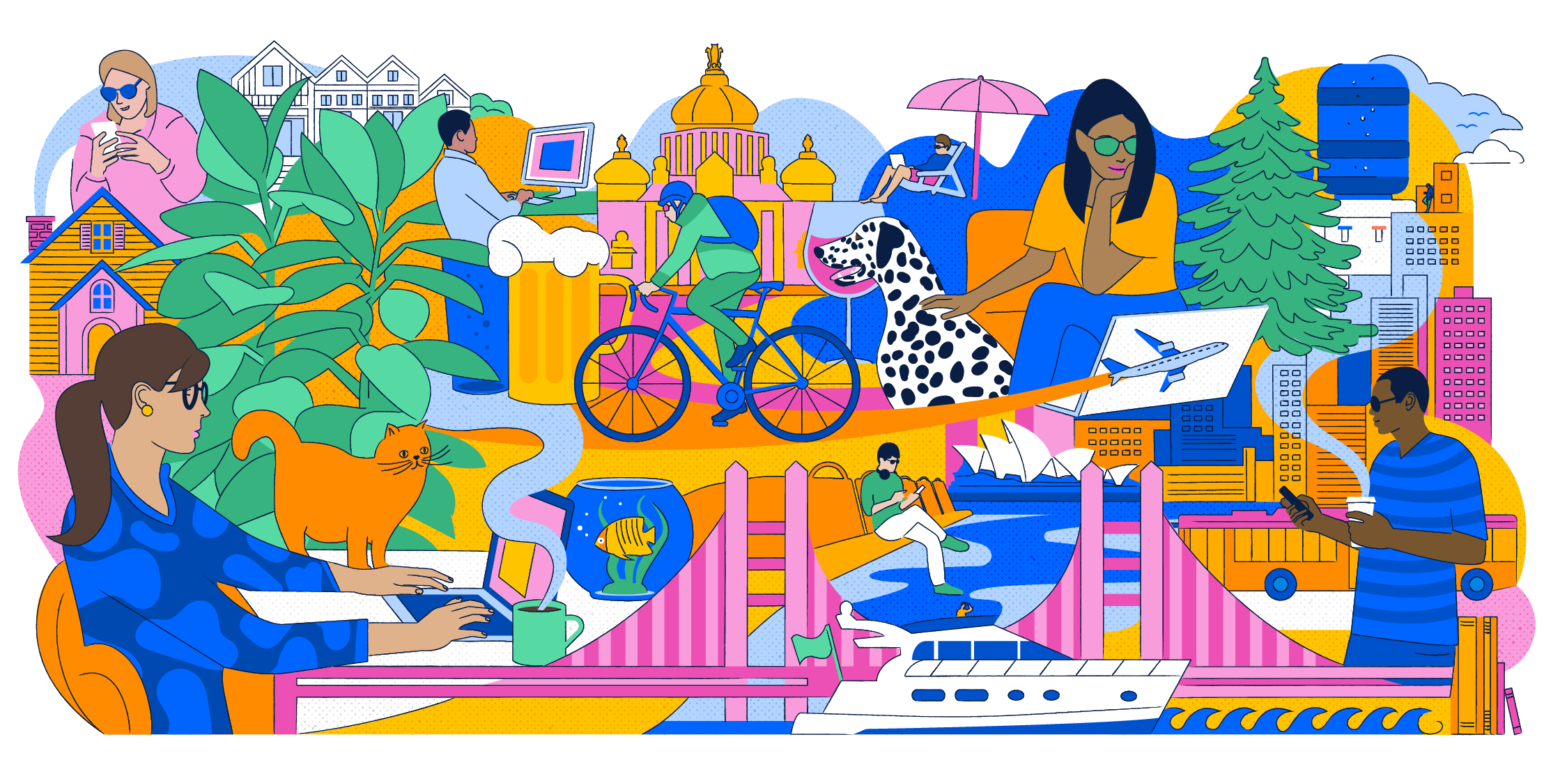5-second summary
- Contrary to popular belief, in person interactions don’t breed creativity. Time, autonomy, and diversity do.
- Company leaders can lay the foundation for more creativity by embracing flexibility around when and where their employees work, which reduces stress and allows creative juices to flow.
- For individuals, relying more on documents and less on real-time brainstorming can result in more creativity (as counter-intuitive as that might sound).
As companies in many (though not all) areas of the world reassess the role of office spaces, remote work detractors have sprung into action. They wring their hands and fuss about how innovation can’t possibly happen without a water cooler for people to gather around.
Seriously? Has anybody ever innovated at a water cooler? I’ve gossiped and procrastinated and bonded with colleagues over our current TV obsessions, but not once have I ever engaged in purposeful creative thinking while refilling my canteen.
It’s not that I don’t understand the nostalgia/amnesia surrounding water coolers. They symbolize everything we love about working alongside others in the same physical space: camaraderie, serendipity, humanity. Simultaneously, many of us reacted to going remote by retreating into safe mode, which has made work feel more transactional and less inspirational. No wonder we conflate the water cooler and creativity.
As if we were oh-so-creative in the first place…
Creative work is hard, period. And I’m not convinced we were ever all that good at it. Most companies are so fixated on productivity metrics that they don’t allow the time and mental breathing space creativity requires. Risk-aversion doesn’t help either, and we’ve understandably seen plenty of risk-averse behavior lately.
In short, we’ve been inadvertently training employees to color inside the lines for some time now. The real question for leaders isn’t how to bring creativity back. It’s “do we actually value creativity?” And if so, “Is that manifest in our culture and policies?”
How executives can create space for creativity
Unlocking creativity starts at the top. Whether your company is fully office-based, fully remote, or somewhere in between, the foundational ingredients are the same.
Embrace distributed collaboration
The grand remote work experiment of 2020-2021 has been bollocks from a methodology perspective. Pandemic-era remote work was forced on us and involved loads of constraints that aren’t present in normal times. So if you’re a remote work skeptic, keep in mind that what you’ve been experiencing wasn’t the real thing. The real thing is much better, although there’s still some complexity involved.
One of the things we’re asking ourselves at Atlassian is how we can make work universally accessible, regardless of a person’s background, identity, needs, and preferences. Because if we get our practices and rituals and ways of working right, then we become agnostic about place. That means we can hire the best fit for the role based on their skills and values, not where they live.
The upside of being able to tap into a more diverse workforce and create a more inclusive environment is huge – not only for society but, selfishly, for us as a business because diverse enterprises outperform their competitors. They generate 130 percent more cash flow per employee and 19 percent more revenue from innovation, compared to their homogeneous counterparts. Why? Because bringing diverse backgrounds and ways of thinking to bear on gnarly problems will supercharge your ability to find a novel and robust solution.
When you see a win-win like that, you go for it. Both diversity and distributed teamwork represent a change for most companies. And change is hard, but it builds resilience.
Help your employees avoid burnout
Productivity metrics are masking an increasingly exhausted workforce. We feel invisible and worry we’ll never get credit for all the good work we’re doing. So to compensate, we’re working longer hours (here’s proof).
But avoiding burnout isn’t just about how many hours we work. Flexibility around schedule and location goes a long way. As long as people are delivering the results you’re asking for, it shouldn’t really matter when or where the work is getting done. For example, some companies require employees to be online or at the office during certain core hours each day – say, 10:00 to 2:00 – to allow for real-time collaboration. The rest of the day is theirs to design as they see fit. For caregivers and anybody with a long commute, this kind of flexibility removes a metric tonne of stress.
Reimagine performance evaluations
We tend to assume that high productivity is the same as high performance. Let’s say an employee fixed 100 bugs or wrote 100 blog posts this year. Great. But to what end? Did the blog posts actually drive sales? Were the bugs they fixed ones that were causing pain for your customers or just the easiest ones to knock out? Output is just the pathway to outcomes, and outcomes are what actually matter.
To be fair, Atlassian isn’t immune to this kind of thinking. So we changed things up a few years ago. We divided our performance reviews into three areas: your individual job performance (focused on outcomes, not output); the extent to which you’re a team player; and how you demonstrate our company values (such as “be the change you seek”) day to day.
That freed up managers to reward creativity and initiative. Creative thinking takes up more time than rote thinking, which puts it at odds with productivity. It takes some unlearning to be OK with that. But ultimately, coming up with a solution for one intractable bug that’s been blocking developers or causing you to hemorrhage customers makes a bigger impact than picking off 100 pieces of low-hanging fruit.
How everyone can unlock more creativity in a hybrid world
If you’re a first-rung manager or individual contributor, you don’t have to wait for higher-ups to get onboard with flexibility or unlearn how they evaluate job performance. Here are two things anybody can start doing today to unleash more creativity.
Keep using video for meetings
I am absolutely, 100 percent over using video for happy hours with friends. But in the workplace, video should remain our default forum for meetings. We tend to interrupt each other less when we’re on video, which means it’s easier for the quieter people in the room to chime in. (The same goes for less senior people, people from historically marginalized groups, and people who don’t think out loud.) So we get more perspectives and ideas on the table – more chances for creative sparks to fly.
If we’re serious about flexible, hybrid work models we need to carry video meetings into our new normal. Trello has always had a video-centric meeting culture that’s worth adopting: when even one person is joining the meeting via video, everyone joins via video. Now, this idea always elicits groans and testimonials about “Zoom doom” as a response. And that’s fair. So instead of meeting in person, maybe just have fewer meetings. Which brings me to…
Rely on asynchronous collaboration more than synchronous collaboration
Anything you can do to democratize conversation and brainstorming unlocks more creativity. And you know what has a democratizing effect? Documents. Writing your ideas down helps you organize and refine them. It also gives your colleagues a chance to review, reflect on, and respond to them whenever their brains are sharpest. It’s a huge win for inclusion and participation – not to mention for the success of your idea.
I’m not saying there’s no room for traditional real-time meetings. I’m saying it’s better to lay your thoughts out on paper first so people can provide some initial feedback. Then you meet to discuss. When you do, everyone in the room will have the context they need to help get your idea to the next step. And because everyone has had the chance to gather their own thoughts asynchronously, the conversation is less likely to be dominated by the most outgoing personality.





 )
) 






































